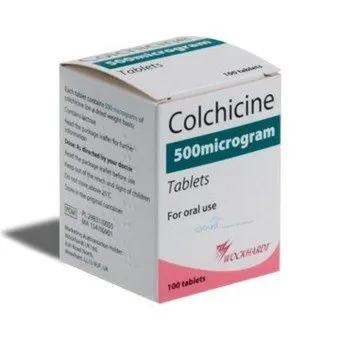Gout

More information
Introduction
Gout is a common and complex form of inflammatory arthritis that can affect anyone. It is characterised by sudden attacks of intense pain often coupled with swelling of the affected area. The severe pain usually occurs in the big toe but also in other joints.
It is a common condition affecting between 1 in 2 in every 100 people in the UK. Gout usually affects males over 30 and women post-menopause. However, it is more common in men than in women. In fact, it is three times more likely to affect men than women.
Treatments
More information
Once an online consultation has been been approved by our medical team, our pharmacy will safely prepare and ship your treatment to you in discreet packaging using Royal Mail or DPD.
What Is Gout?
Gout is a common type of arthritis that is characterised by sudden attacks of severe joint pain. It typically occurs in the big toe but can affect other joints in the hands, feet, elbows and wrists.
Attacks of gout can happen without warning, sometimes in the middle of the night. While some people experience gout episodes frequently, others can go years between attacks.
Gout Symptoms
The main symptom of a gout attack is sudden, severe joint pain. This could be one joint – usually the big toe – or several.
Other symptoms of gout can include:
- Intense Joint Pain: This usually occurs in the large joint of your big toe but can also occur in any joint. The pain is most severe within the first 4 - 12 hours
- Swelling: The area of the joint directly affected will be swollen and also tender, warm and red
- Peeling or flaky skin as the swelling subsides
- Limited range of motion: As gout progresses, you may not be able to move your joints normally
- Lingering discomfort: When the most severe pain passes, some discomfort in the joint may remain from a period of a few days to a few weeks. Any subsequent attacks are likely to last longer and affect more joints
On average, an episode of gout can last from three to 10 days, with or without medication. Some people may only have one attack in their lifetime, but without treatment or drastic change in diet and other risk factors, attacks may occur more frequently.
What Causes Gout?
Gout is caused by high levels of uric acid in the body. Uric acid is produced by the body when purines – chemicals that are found in some types of food and drinks – are broken down. It is a byproduct that goes through the kidneys before exiting the body in urine. When the body creates too much uric acid, or the kidneys aren’t able to handle it, sharp uric acid crystals form in the joints, causing gout. It should be noted that not everyone with high uric acid levels suffers from gout.
There are several risk factors attached to gout. Although the condition can affect anyone, men are more likely than women to get it. This is because, for most of their lives, men have higher uric acid levels than women. When gout occurs in women, it tends to be after menopause. You are also more likely to get gout if you:
- Are obese
- Have diabetes
- Have congestive heart failure
- Have a family history of gout
- Have kidney disease
- Have high blood pressure (hypertension)
- Eat a lot of meat
- Take diuretics (water pills)
- Drink a lot of alcohol
Foods That Cause Gout
As we have outlined in the section above, certain types of food and drinks can be triggers for gout. These foods include:
- Red meat, including beef and pork
- Seafood, including cod, salmon and shellfish
- Offal (organ meats), including heart, liver, brains and intestines
- Fruit juice
- Alcohol
- Fizzy soft drinks
How Is Gout Diagnosed?
We recommend that you visit your GP if you suspect gout without previously being diagnosed. This is more so important when your symptoms are accompanied by a temperature of over 38 degrees celsius. In the majority of cases, your GP or doctor will be able to diagnose gout based on the symptoms presented. However, they will also take into account your past medical history and examine the joint.
Testing for gout is carried out to both confirm the diagnosis and rule out other potential causes. These include:
- Blood Tests: This measures the amount of uric acid in the blood
- Ultrasound Scan: This method detects crystals in the joints
- X-Ray: Whilst gout is rarely detectable on an X-Ray, a scan can help assess any damage caused by gout. Additionally, X-Rays can help rule out any similar joint conditions such as chondrocalcinosis, which is an accumulation of calcium crystals in the joint
How Long Does Gout Last?
Gout attacks typically last from five to seven days, before improving. However, some episodes can last up to two weeks without treatment. It is important to get immediate treatment, both to relieve symptoms and prevent lasting damage. Gout is a chronic condition - attacks come and go, and the time between attacks will vary from person to person. Some people respond better to gout treatment than others.
Stages of Gout
There are several stages of gout progression, which we will cover below:
- Stage 1: High uric acid levels – also known as the asymptomatic stage. During this time, uric acid builds up in the blood and begins to form crystals at the joints, typically in the foot. There are no symptoms at this stage, and for this reason, a person will not be diagnosed with gout at this time – high uric acid levels don’t cause gout in everybody.
- Stage 2: Acute gout – this is the stage at which gout attacks can occur suddenly. A person with gout may wake up in the middle of the night with severe pain, commonly in the big toe, but also in other joints. They are also likely to see swelling and redness of the joint. An inflammatory reaction is caused by the release of urate crystals into the joint fluid.
- Stage 3: Intercritical gout - following an initial gout attack, the majority of people will experience a second within one year. During the time in between gout flare-ups, there may not be any pain or swelling at the joints – this is known as the intercritical gout stage. Most patients will go through this ‘quiet’ phase when there are few symptoms, but gout treatment can continue to lower uric acid levels.
- Stage 4: Chronic gout – also known as the ‘tophaceous gout’ stage, this is when a person can experience painful symptoms almost continuously. Chronic gout happens when uric acid deposits create tophi (abnormal tissue growths), which can form at the big toe’s bunion point, or another joint. The chronic gout stage usually develops over years of the condition being improperly treated and can cause progressive joint damage.
Pseudogout vs Gout
Gout can sometimes be confused with calcium pyrophosphate dihydrate crystal deposition disease (CPPD), also known as pseudogout. Pseudogout also involves crystal build-up, but there are distinct differences between the two conditions.
Both gout and pseudogout are forms of arthritis, but they are caused by different types of crystals. While gout is caused by uric acid crystals, pseudogout is caused by an abnormal build-up of calcium pyrophosphate dihydrate crystals.
Gout symptoms such as sudden, severe pain, redness, tenderness and swelling are often felt in the big toe. Pseudogout symptoms can be similar, occurring abruptly, but more often affecting the wrist, knee and ankle, as well as spinal ligaments. Gout and pseudogout are diagnosed similarly, but while gout can be diagnosed with a CT scan, this test isn’t used for pseudogout. Both gout and pseudogout can be treated with non-steroidal anti-inflammatory drugs (NSAID), colchicine and corticosteroids.
How to Prevent Gout
If you have gout, there are several ways in which you can help to prevent it from coming back. Here are some tips:
- Take medicine as soon as possible and it should work within 3 days
- Rest
- Keep the affected limb raised as much as possible
- Apply ice treatment at home using an ice pack (a bag of frozen food will work, too)
- Avoid covering the affected joint with your bedsheets at night
- Drink a lot of water
- Avoid putting pressure on the affected area
- Avoid foods and drinks known to trigger gout, such as red meat and alcohol
- Exercise as much as you can, as physical activity can help to lower uric acid levels
- Don’t smoke
Gout Treatment
There are two types of medication used to treat gout. The first type reduces gout attack symptoms such as pain and inflammation and includes:
- NSAIDs (such as diclofenac sodium tablets, naproxen tablets and ibuprofen tablets)
- Colchicine tablets
- Corticosteroids
NSAID
These are non-steroidal anti-inflammatory drugs (NSAIDs). This group of painkillers will help manage the pain and reduce any inflammation. The above medicines are often prescribed alongside proton-pump inhibitors (PPIs) because NSAIDs can increase the risk of indigestion and stomach irritation, which the PPI will help to counter. NSAIDs should be taken immediately at the onset of an attack, and for 48 hours afterwards.
Colchicine
If NSAIDs are unsuitable or not proven effective, then a medicine called Colchicine can be used. This will reduce the swelling and relieve the pain during a gout attack.
The second type of gout treatment prevents gout complications and can include uric acid production blockers such as allopurinol and febuxostat, as well as medications like probenecid which help the kidneys remove uric acid from the body.
How Can I Prevent Gout?
Preventing gout can be done in several ways, including lifestyle changes and preventative medicines. Making the right dietary and lifestyle choices – such as limiting alcohol and red meat, and exercising regularly - are also important to preventing recurrent gout flare-ups.
Urate-lowering therapy uses medicines, such as allopurinol, to lower the levels of uric acid in the blood. This is recommended for those who suffer from recurrent attacks, and for individuals who experience complications such as kidney stones or joint damage. Lifestyle changes can also reduce the risk of gout and they include:
- Get to a healthy weight
- Have a balanced and healthy diet with plenty of vegetables and low-fat dairy foods
- Avoid alcohol for at least 2 days per week (and less than 14 units per week)
- Exercise regularly - physical activities which have less impact on the joints, such as cycling and swimming, are preferable
- Stop smoking
Guides
How it works

First...
Complete a quick eligibility check

Then...
Order your treatment

Finally.
Fast, confidential delivery to your door




















